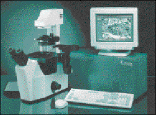
Laser Catapults Progress in Gene Analysis
Aaron J. Hand
To better understand how cancers develop, molecular biologists seek to analyze genes at the single-cell level. Lasers have played an important role in capturing individual cells, but it has been difficult to effectively isolate tumor cells from surrounding cells.

Researchers at the Academic Hospital München-Harlaching use Palm's Robot-MicroBeam nitrogen laser to completely isolate individual cells for gene analysis.
Researchers at the Academic Hospital München-Harlaching have come up with a method that dissects and removes selected cells of a variety of shapes and sizes. It does so without mechanical contact, leaving the chosen cell or cell cluster contamination-free for gene expression analysis. The scientists use a 337-nm pulsed nitrogen laser -- the Robot-MicroBeam from Palm GmbH in Wolfratshausen, Germany.
The first step in the process is laser microbeam microdissection, in which the laser beam cuts around the desired cell. This typically requires a 3-ns pulse of 120 to 300 µJ. One benefit of this method is that it leaves a 1- to 10-µm gap around the chosen cell, completely isolating it from surrounding tissue.
After the cell is dissected, the same laser -- with about twice the energy level -- is focused below the target specimen. One or a few laser shots, depending on the size of the sample, catapults the target specimen into the cap of a sample tube.
A comparable method, laser capture microdissection developed by the National Institutes of Health in the US, uses an infrared laser to fuse the desired cell to a transfer film. Although this theoretically captures an uncontaminated cell, researchers have reported problems. "As we heard from other investigators ... it was difficult to prepare specimens that were not round-shaped, and very often, unwanted material was sticking to the membrane," said Georgia Lahr, head of the hospital's molecular biology lab and a researcher involved in the new method.
Compared with previous nitrogen laser-based systems, the Robot-MicroBeam is relatively small and easy to handle, according to the researchers. The basic system, which combines a cutting laser with one or two sets of optical tweezers, requires less than one square meter of table space, according to Christoph Koeppen, assistant manager at Palm.
The MicroBeam has been on the market for about five years, and several systems have been sold worldwide, including one to the National Institutes of Health. But Palm has worked closely with the latest microdissection method's other researcher -- Karin Schütze, head of the hospital's laser lab -- to get the system to its current state. "Because she uses the system herself under everyday circumstances in a standard [molecular biology] lab, the hardware and software are optimized for real-life work," Koeppen said.
Published: September 1998